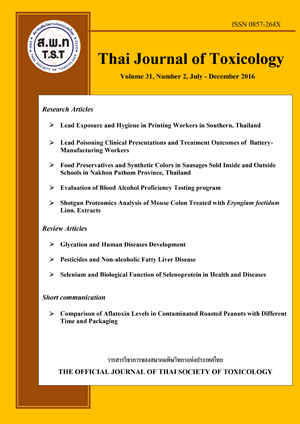Lead Exposure and Hygiene in Printing Workers in Southern, Thailand
Main Article Content
Abstract
The objectives of this study were to determine the lead levels in blood samples from printing workers and airborne samples. For describe the workers' hygiene behavior, adverse health effects and ascertain and describe any correlations between lead levels in blood samples and airborne samples. A cross-sectional study conducted by interviewing 75 printing workers in 16 printing factories. Comparison was made with a reference group of 75 non-exposed persons. The sampling was selected by purposive selection. Lead levels were determined by atomic absorption spectrometry, at a wavelength of 283.3 nm. Descriptive data were analyzed by descriptive statistics such as percentage, mean, and standard deviation. Comparative data analysis used independent t-test and inferential statistics with a multiple linear regression with a level of significance at 0.05. The results in this study showed that most subjects were male (65.3%) and aged between 20-30 years (53.3%). Most printing workers (72.0%) had worked ≥ 10 years. The exposed group has mean airborne lead level 15.00 ± 4.54 μg/m3 (range 10-25 μg/m3). The mean blood lead level of the exposed group (6.61 ± 3.71μg/dL) was significantly higher than the reference group (2.07 ± 1.03 μg/dL, p<0.001). A statistically significant positive correlation was found between airborne lead levels and blood lead levels (r = 0.570, p < 0.01). This behavior had a significant correlation to their blood lead levels (p < 0.001). Improvements to occupational health education, and working conditions are required due to these correlations.


